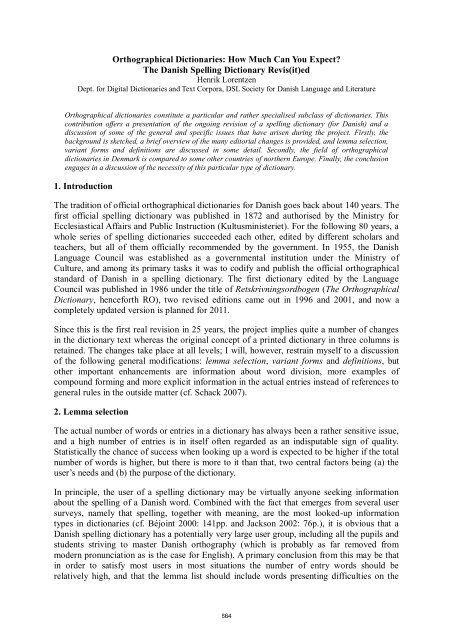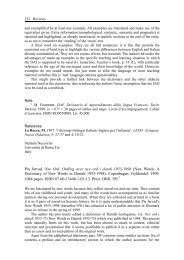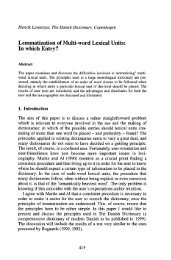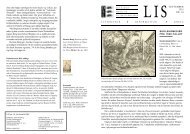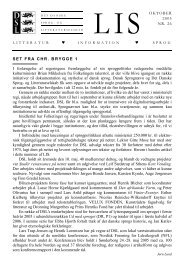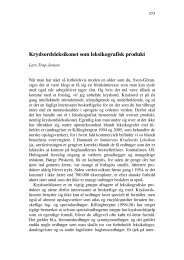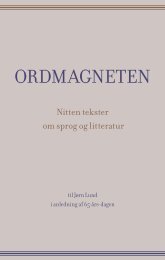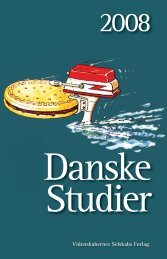The Danish Spelling Dictionary Revis(it) - Det Danske Sprog- og ...
The Danish Spelling Dictionary Revis(it) - Det Danske Sprog- og ...
The Danish Spelling Dictionary Revis(it) - Det Danske Sprog- og ...
Create successful ePaper yourself
Turn your PDF publications into a flip-book with our unique Google optimized e-Paper software.
Orth<strong>og</strong>raphical Dictionaries: How Much Can You Expect?<strong>The</strong> <strong>Danish</strong> <strong>Spelling</strong> <strong>Dictionary</strong> <strong>Revis</strong>(<strong>it</strong>)edHenrik LorentzenDept. for Dig<strong>it</strong>al Dictionaries and Text Corpora, DSL Society for <strong>Danish</strong> Language and L<strong>it</strong>eratureOrth<strong>og</strong>raphical dictionaries const<strong>it</strong>ute a particular and rather specialised subclass of dictionaries. Thiscontribution offers a presentation of the ongoing revision of a spelling dictionary (for <strong>Danish</strong>) and adiscussion of some of the general and specific issues that have arisen during the project. Firstly, thebackground is sketched, a brief overview of the many ed<strong>it</strong>orial changes is provided, and lemma selection,variant forms and defin<strong>it</strong>ions are discussed in some detail. Secondly, the field of orth<strong>og</strong>raphicaldictionaries in Denmark is compared to some other countries of northern Europe. Finally, the conclusionengages in a discussion of the necess<strong>it</strong>y of this particular type of dictionary.1. Introduction<strong>The</strong> trad<strong>it</strong>ion of official orth<strong>og</strong>raphical dictionaries for <strong>Danish</strong> goes back about 140 years. <strong>The</strong>first official spelling dictionary was published in 1872 and authorised by the Ministry forEcclesiastical Affairs and Public Instruction (Kultusministeriet). For the following 80 years, awhole series of spelling dictionaries succeeded each other, ed<strong>it</strong>ed by different scholars andteachers, but all of them officially recommended by the government. In 1955, the <strong>Danish</strong>Language Council was established as a governmental inst<strong>it</strong>ution under the Ministry ofCulture, and among <strong>it</strong>s primary tasks <strong>it</strong> was to codify and publish the official orth<strong>og</strong>raphicalstandard of <strong>Danish</strong> in a spelling dictionary. <strong>The</strong> first dictionary ed<strong>it</strong>ed by the LanguageCouncil was published in 1986 under the t<strong>it</strong>le of Retskrivningsordb<strong>og</strong>en (<strong>The</strong> Orth<strong>og</strong>raphical<strong>Dictionary</strong>, henceforth RO), two revised ed<strong>it</strong>ions came out in 1996 and 2001, and now acompletely updated version is planned for 2011.Since this is the first real revision in 25 years, the project implies qu<strong>it</strong>e a number of changesin the dictionary text whereas the original concept of a printed dictionary in three columns isretained. <strong>The</strong> changes take place at all levels; I will, however, restrain myself to a discussionof the following general modifications: lemma selection, variant forms and defin<strong>it</strong>ions, butother important enhancements are information about word division, more examples ofcompound forming and more explic<strong>it</strong> information in the actual entries instead of references t<strong>og</strong>eneral rules in the outside matter (cf. Schack 2007).2. Lemma selection<strong>The</strong> actual number of words or entries in a dictionary has always been a rather sens<strong>it</strong>ive issue,and a high number of entries is in <strong>it</strong>self often regarded as an indisputable sign of qual<strong>it</strong>y.Statistically the chance of success when looking up a word is expected to be higher if the totalnumber of words is higher, but there is more to <strong>it</strong> than that, two central factors being (a) theuser’s needs and (b) the purpose of the dictionary.In principle, the user of a spelling dictionary may be virtually anyone seeking informationabout the spelling of a <strong>Danish</strong> word. Combined w<strong>it</strong>h the fact that emerges from several usersurveys, namely that spelling, t<strong>og</strong>ether w<strong>it</strong>h meaning, are the most looked-up informationtypes in dictionaries (cf. Béjoint 2000: 141pp. and Jackson 2002: 76p.), <strong>it</strong> is obvious that a<strong>Danish</strong> spelling dictionary has a potentially very large user group, including all the pupils andstudents striving to master <strong>Danish</strong> orth<strong>og</strong>raphy (which is probably as far removed frommodern pronunciation as is the case for English). A primary conclusion from this may be thatin order to satisfy most users in most s<strong>it</strong>uations the number of entry words should berelatively high, and that the lemma list should include words presenting difficulties on the664
Henrik Lorentzenorth<strong>og</strong>raphical level. Furthermore, <strong>it</strong> seems evident that new words should be included sincethere may be uncertainty as to their spelling (or inflection), especially in the case ofloanwords. It is far more doubtful whether old, rare and technical words have a right to be inan orth<strong>og</strong>raphical dictionary. As <strong>it</strong> happens, of the 60,000 words in the 1986 version of the<strong>Danish</strong> spelling dictionary almost 10,000 words were not included in the first draft version ofDen <strong>Danske</strong> Ordb<strong>og</strong> (<strong>The</strong> <strong>Danish</strong> <strong>Dictionary</strong>), a corpus-based dictionary of modern <strong>Danish</strong>(Lorentzen 2008). This gives food for thought and has undoubtedly urged the ed<strong>it</strong>ors of thefuture revised version to exclude a considerable amount of this part of the vocabulary.<strong>The</strong> question remains, however, how many words should be included: should the number ofheadwords be reduced because of this elimination of marginal vocabulary or should <strong>it</strong>, on thecontrary, be augmented w<strong>it</strong>h words that actually occur in the language? My personal view isin accordance w<strong>it</strong>h the latter option, but discussions in the ed<strong>it</strong>orial group reveal differentopinions. If the principal purpose of the orth<strong>og</strong>raphical dictionary is to provide help inproducing language, i.e. correct spellings and inflections, <strong>it</strong> is argued that a good stock ofsimplex words is important, combined w<strong>it</strong>h a certain amount of compounds and a good dealof examples illustrating how to form more compounds. Filling the dictionary w<strong>it</strong>h occasionalcompounds is not considered relevant. If, on the other hand, the purpose is documenting thevocabulary of the language, this is a good reason to include a lot of compounds, provided theyoccur in a corpus as evidence of them being used in actual language. Seen from the user’sperspective <strong>it</strong> is also an advantage if the lemma list contains many headwords as <strong>it</strong> is rathercomforting for a user to find the particular word he or she is looking for, as an indication of <strong>it</strong>susabil<strong>it</strong>y. Reception (decoding) seems a less relevant purpose when spelling or inflection isconcerned, but <strong>it</strong> comes into play when talking about meaning (see section 4).<strong>The</strong> reluctance to add so-called transparent compounds to the lemma list may also stem fromthe idea that the end product is a printed book w<strong>it</strong>h a lim<strong>it</strong>ed number of pages in order to caterfor <strong>it</strong>s use in classroom and examination s<strong>it</strong>uations. As emerged from several papers presentedat the eLexic<strong>og</strong>raphy conference in Louvain-la-Neuve in October 2009 (e.g. Nesi andPiotrowski, both forthcoming) the s<strong>it</strong>uation is rapidly changing from printed books to smallhand-held devices, so there seem to be very few good arguments in favour of restricting theamount of vocabulary, although a relevant and realistic exception is that of funding andmanpower.3. Variant formsAs stated by Davidsen-Nielsen (2002: 35) there are always cases where words can be spelt indifferent ways. He further claims that in the case of <strong>Danish</strong> the official norm allows too manyspelling variants, taking the example of virus that used to have 14 different official formsincluding variants in both singular and plural:virus (singular indefin<strong>it</strong>e)virusen, virussen, viruset, virusset (singular defin<strong>it</strong>e)viruser, virusser, virus, vira (plural indefin<strong>it</strong>e)viruserne, virusserne, virusene, virussene, viraene (plural defin<strong>it</strong>e)In 2001 this rather confusing abundance of forms was reduced to 9 because the optionalgemination of the s was abandoned. Davidsen-Nielsen argues that the current revision of thespelling dictionary could further reduce the number of forms to 4 thus bringing the lemma665
Section 3. Reports on Lexic<strong>og</strong>raphical and Lexicol<strong>og</strong>ical Projectsvirus in line w<strong>it</strong>h the vast major<strong>it</strong>y of <strong>Danish</strong> nouns that have only 4 inflectional forms 1 :virus (singular indefin<strong>it</strong>e)virussen (singular defin<strong>it</strong>e)virusser (plural indefin<strong>it</strong>e)virusserne (plural defin<strong>it</strong>e)<strong>The</strong> very fact of having an official orth<strong>og</strong>raphical norm somehow conflicts w<strong>it</strong>h having a lotof optional forms w<strong>it</strong>hin the norm, and language users often express a need for clear answers,not a variety of possibil<strong>it</strong>ies to choose from. On the other hand, many forms have existedalongside each other for a long time, and discarding one in favour of another might be felt astoo author<strong>it</strong>arian. <strong>The</strong> policy of the ed<strong>it</strong>orial group is to accept a number of optional forms butonly those that are found necessary. This of course implies invidual decisions generally basedon corpus studies combined w<strong>it</strong>h systematical principles such as anal<strong>og</strong>y and consistency.Thus a number of variant forms can be eliminated at word level, e.g. federalisme/føderalisme(‘federalism’) where the Danicized form føderalisme is predominant in actual use, and theoppos<strong>it</strong>e case: schweizisk/svejtsisk (‘Swiss’, adjective) where the more <strong>Danish</strong>-looking variantsvejtsisk tends to be rare in corpus texts. <strong>The</strong> consistency principle applies to a number ofinflectional forms, for example nouns ending in -el, which at present have an optional -e- inthe singular defin<strong>it</strong>e form: kabel – kablet/kabelet (‘cable’), cykel – cyklen/cykelen (‘bicycle’).<strong>The</strong> tendency in actual usage is to prefer the syncopated form (kablet, cyklen) and byexcluding the non-syncopated forms for this group of words, a considerable reduction ofinflectional variants could be obtained as well as a transparent and consistent principle.An alternative to the possibil<strong>it</strong>ies now applied in the RO, i.e. e<strong>it</strong>her one or more variant formsvs. one single authorised form, might be the one used in SAOL (Wordlist of the SwedishAcademy); here the concept of prescription is introduced. When two variant forms areconsidered equally usable they are given like this: sprej or spray (no prescription), but whereone of the variant forms is regarded less usable, <strong>it</strong> is introduced by the comment also: sjalalso schal (‘shawl’) meaning that the former word form is prescribed. This compromise hasbeen discussed in the <strong>Danish</strong> Language Council but this more fine-grained distinctionbetween straightforward variants and prescribed variants has not been considered su<strong>it</strong>able, therationale being that if you can recommend one form and not the other you might as well makea clear-cut decision and eliminate the non-recommended form.4. Defin<strong>it</strong>ionsUp till now there has only been l<strong>it</strong>tle information about meaning in the <strong>Danish</strong> spellingdictionary. In fact a frequent reaction when first becoming acquainted w<strong>it</strong>h <strong>it</strong>, is ‘what do Iactually get in this dictionary?’ In orth<strong>og</strong>raphical dictionaries for German and Swedish <strong>it</strong> ismuch more common to give semantic information but in the <strong>Danish</strong> spelling dictionary theguiding principle was only to give enough information to distinguish homonyms or othercases where confusion is likely to occur, such as the following entries from the 2001 ed<strong>it</strong>ion:1. bark sb. ... (lag på træ ‘layer on wood’)2. bark sb. ... (fartøj ‘vessel’)amnesi sb. ... (svækkelse af hukommelse ‘weakening of memory’)amnesti sb. ... (eftergivelse af straf ‘remission of sentence’)1 And also w<strong>it</strong>h English dictionaries such as MACMILLAN, which only gives the forms virus (singular) andviruses (plural).666
Section 3. Reports on Lexic<strong>og</strong>raphical and Lexicol<strong>og</strong>ical Projects<strong>The</strong> possibil<strong>it</strong>ies reflect the dichotomy norm vs. description w<strong>it</strong>h no. 1 being strictlynormative, no. 3 strictly descriptive and no. 2 in between. In view of the above-mentionedtendency to interpret dictionary data normatively, no. 2 may represent a reasonablecompromise by informing of actual usage and at the same time displaying a warning signsaying ‘this use may not be accepted by everyone’. This is in fact the solution adopted in thecorpus-based DDO (<strong>The</strong> <strong>Danish</strong> <strong>Dictionary</strong>), which intends to combine description andprescription. See Trap-Jensen (2002) for further discussion of descriptive and normativeaspects in dictionary making.5. Other orth<strong>og</strong>raphical dictionariesAs mentioned above, the <strong>Danish</strong> spelling dictionary is official and authorised by law as theway the <strong>Danish</strong> Language Council communicates the orth<strong>og</strong>raphy standard to the generalpublic, a standard the national and local author<strong>it</strong>ies as well as the educational system areobliged to use. This means that the spelling dictionary of the Language Council enjoysmonopoly status, a status that was nevertheless infringed in 1996 and 2001 so that Denmarknow has two unofficial spelling dictionaries (GRO and PRO). Among their main features are ahigher number of entry words and more defin<strong>it</strong>ions, features that are partly taken into accountin the revision of the official RO.Germany has a long history of orth<strong>og</strong>raphical dictionaries but not one authorised bygovernment. However, DUDEN functions in practice as conveyor of the norm and not onlythat, <strong>it</strong> also gives a lot of add<strong>it</strong>ional information on, for instance, grammar, pronunciation,etymol<strong>og</strong>y and meaning, thus approaching the general-purpose dictionary (Nerius 1990:1302).In Sweden, there is no official spelling dictionary e<strong>it</strong>her but unofficially SAOL has the role ofdefining the standard of Swedish orth<strong>og</strong>raphy. <strong>The</strong> wordlist, which in <strong>it</strong>s latest ed<strong>it</strong>ion is abook w<strong>it</strong>h 1130 pages and 125,000 headwords (RO 2001: 749 pages and 64,000 headwords),has been published since 1874, two years after the publication of the first <strong>Danish</strong> spellingdictionary. Apart from orth<strong>og</strong>raphy and inflections <strong>it</strong> provides a certain amount of informationon pronunciation, meaning and word division.<strong>The</strong> example entries in Table 1 clearly illustrate the differences in the amount and type ofinformation provided by four spelling dictionaries. For ease of understanding and comparisonthe entry word is the English loanword pacemaker (smaller differences from the originalnotation may occur).DUDEN:Pace|ma|ker [...me:kE], der; -s, - (Pacemacher;Med.: Herzschr<strong>it</strong>tmacher)SAOL:pace|maker [pej’smejk-] s. -n pacemakrar •hjärtstimulator; farthållare i löpningPRO: RO 2001:pace∙maker sb. (apparat) -en, -e, -nepacemaker sb., -en, -e, bf. pl. pacemakerne.Table 1: <strong>The</strong> entry pacemaker in four different spelling dictionaries.<strong>The</strong> German DUDEN and the Swedish SAOL both give more information than justorth<strong>og</strong>raphy and inflection, indicating pronunciation, word division and two different senses.PRO, one of the unofficial <strong>Danish</strong> spelling dictionaries, is more sparing but provides668
Henrik Lorentzennevertheless the word division and a short gloss for one of the possible senses 2 . RO, however,restricts <strong>it</strong>self to conveying a minimum: orth<strong>og</strong>raphy and inflection. As stated above,especially in Section 4, this is going to change in the ed<strong>it</strong>ion under preparation: word divisionwill be provided for all headwords and semantic information in the form of glosses ordefin<strong>it</strong>ions will be given in many more cases than was common in earlier ed<strong>it</strong>ions. As a resultof this policy, the future entry for pacemaker is likely to look like this:RO 2011:pace|maker sb., -en, -e, -ne (elektronisk apparat der stimulerer hjerterytmen).6. ConclusionsWhen considering the German DUDEN and the Swedish SAOL as well as the unofficial<strong>Danish</strong> spelling dictionaries, there is no doubt that some of their main features have served asinspiration for the next ed<strong>it</strong>ion of the <strong>Danish</strong> RO, in particular information on meaning byway of defin<strong>it</strong>ions and information on word division. Now the question is: Why have a specialspelling dictionary? It could be argued that spelling is just one information type among others.And once other elements than orth<strong>og</strong>raphy and morphol<strong>og</strong>y such as defin<strong>it</strong>ions areintroduced, <strong>it</strong> might no longer be reasonable to maintain the spelling dictionary as a subtypeof <strong>it</strong>s own (cf. discussions of polyfunctional<strong>it</strong>y by Bergenholtz 1997 and Nerius 1990 amongothers).Seen from the narrow <strong>Danish</strong> perspective, there seem to be good arguments in favour ofpreserving the spelling dictionary since the law stipulates that the Language Council isresponsible for defining the official orth<strong>og</strong>raphy and for making <strong>it</strong> accessible to the <strong>Danish</strong>population. But <strong>it</strong> is not absolutely certain that <strong>it</strong> need be in the form of one particular,physical dictionary: the important thing is to communicate this highly relevant informationtype to the relevant users (probably most of the potential users), and why not as part of a moregeneral reference work as long as the spellings are clearly indicated to be in accordance w<strong>it</strong>hofficial recommendations?2 <strong>The</strong> sports sense of pacemaker (‘someone who sets the pace in a race’) is uncommon in <strong>Danish</strong>, this sensegenerally being conveyed by the word pacer.669
Section 3. Reports on Lexic<strong>og</strong>raphical and Lexicol<strong>og</strong>ical ProjectsReferencesBéjoint, H. (2000). Modern Lexic<strong>og</strong>raphy: An Introduction. Oxford: Oxford Univers<strong>it</strong>y Press.Bergenholtz, H. (1997). ‘Polyfunktionale ordbøger’. In LexicoNordica 4. 15-29.Davidsen-Nielsen, N. (2002). ‘Remarks on Dictionaries – w<strong>it</strong>h Special Reference to Grammar,Pronunciation and Orth<strong>og</strong>raphic Variation’. In Braasch, A.; Povlsen, C. (eds.). Proceedings of theTenth EURALEX International Congress. Copenhagen. 29-38.DDO = Den <strong>Danske</strong> Ordb<strong>og</strong> 1-6. København: <strong>Det</strong> <strong>Danske</strong> <strong>Spr<strong>og</strong></strong>- <strong>og</strong> L<strong>it</strong>teraturselskab <strong>og</strong> Gyldendal.2003-2005.DUDEN = Duden – Die deutsche Rechtschreibung. 22. Auflage. Mannheim: Dudenverlag. 2001.GRO = Retskrivningsordb<strong>og</strong>. København: Gyldendal 1996, 2001.Jackson, H. (2002). Lexic<strong>og</strong>raphy: An Introduction. London/New York: Routledge.Lorentzen, H. (2008). ‘Korpusbaseret lemma-eksklusion eller ‘Hvor gik ordene hen da de gik ud?’’. InJóhannesson, K. et al. (eds.). N<strong>og</strong> ordat? Festskrift till Sven-Göran Malmgren. Göteborg. 259-267.MACMILLAN = Macmillan English <strong>Dictionary</strong> online: http://www.macmillandictionary.com [accessdate: 26 Feb. 2010].Nerius, D. (1990). ‘Das Orth<strong>og</strong>raphiewörterbuch’. In Hausmann, F. J. et al. (eds.). Wörterbücher /Dictionaries / Dictionnaires. Bd. 1–3. 1989–1991. Berlin/New York: Walter de Gruyter. 1297-1304.Nesi, H. (forthcoming). ‘E-dictionaries and Language Learning: Uncovering Dark Practices’. InGranger, S.; Paquot, M. (eds.). Proceedings of eLexic<strong>og</strong>raphy in the 21 st century: New challenges,new applications. Louvain-la-Neuve.Piotrowski, T. (forthcoming). ‘Mobile Dictionaries: S<strong>it</strong>uations of Use’. In Granger, S.; Paquot, M.(eds.). Proceedings of eLexic<strong>og</strong>raphy in the 21 st century: New challenges, new applications.Louvain-la-Neuve.PRO = Pol<strong>it</strong>ikens Retskrivningsordb<strong>og</strong>. København: Pol<strong>it</strong>ikens Forlag. 2001.RO = Retskrivningsordb<strong>og</strong>en. København: Dansk <strong>Spr<strong>og</strong></strong>nævn. 1986, 1996, 2001.SAOL = Svenska Akademiens ordlista. 13. upplagan. Stockholm: Norstedts Akademiska Förlag. 2006.Schack, J. (2007). ‘Eventuelle ændringer i en kommende udgave af Retskrivningsordb<strong>og</strong>en”. InSandersen, V.; Schack, J. (eds.). Dansk <strong>Spr<strong>og</strong></strong>nævn – godt <strong>og</strong> vel 50 år efter. København. 93-103.Trap-Jensen, L. (2002). ‘Descriptive and Normative Aspects of Lexic<strong>og</strong>raphic Decision-Making: <strong>The</strong>Borderline Cases’. In Braasch, A.; Povlsen, C. (eds.). Proceedings of the Tenth EURALEXInternational Congress. Copenhagen. 503-509.670


